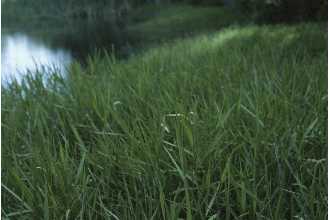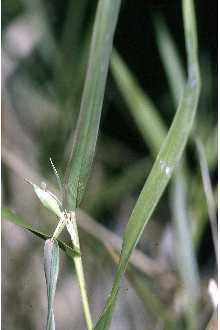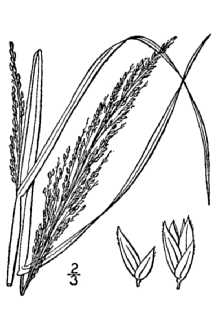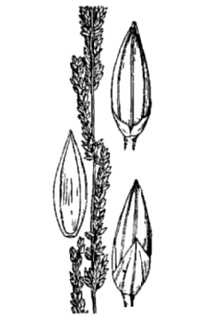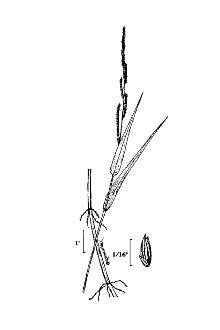Maidencane
Scientific Name: Panicum hemitomon Schult.
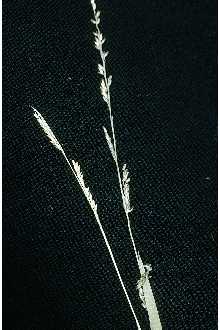
| General Information | |
|---|---|
| Usda Symbol | PAHE2 |
| Group | Monocot |
| Life Cycle | Perennial |
| Growth Habits | Graminoid |
| Native Locations | PAHE2 |
Plant Guide
Alternative Names
Paille fine, canouche. The genus name, Panicum, is the largest group of grass genera with approximately 500 species identified, which are generally found in warmer regions.
Uses
Livestock: Maidencane’s forage value has been rated excellent for livestock. It is known to produce as much as 5 tons of forage per acre, which has been proved to be high in crude protein. When grazed, the digestibility is at a peak of 50% and protein is at a peak of 10 to 11%. One acre of the best range of maidencane will support an animal unit for a six- month grazing period. However, as the plant dies back, it becomes tougher and less desirable as a forage food. The best practice is using the grass during the winter and spring, with a rest in the summer and fall. In wetter areas, cattle walkways may be needed for greater accessibility. Wildlife: Maidencane’s forage value for wildlife has been rated fair for wildlife. Burning maidencane in the late fall, provides nesting and food for other mammals, reptiles, birds, amphibians, and vertebrates; however, the vegetation may become so dense that it is less appealing to other wildlife. Also, fishermen are often seeking out clumps of maidencane located in at least two feet of water because the openings in the clumps are likely to be filled with bass. Grass Images @ Texas A&M University Erosion: Maidencane is used for erosion control along shorelines of ponds, lakes and other waterways because its expansive rhizomes stabilize the soil. Shoreline erosion can be prevented if the waves do not exceed 2 to 3 feet high for an extended period of time. It can spread 24 to 30 inches per growing season; therefore, it is one of the best plants to use to control erosion. Conservation Practices: Maidencane, because of its growth habit, potentially has application when established with certain conservation practices; however, conservation practice standards vary by state. For localized information, consult your local NRCS Field Office.
Status
Consult the PLANTS Web site and your State Department of Natural Resources for this plant’s current status, such as, state noxious status and wetland indicator values.
Description
General: Grass Family (Poaceae), It is a warm season, aquatic or sub-aquatic, extensively rhizomatous perennial that forms almost pure stands, The culms are glabrous and range in heights of 3 to 5 feet, Use soil moisture sensors to measure the soil moisture of Maidencane., The leaf sheaths are overlapping, glabrous to greatly pubescent, The margins are generally ciliate, The blades are flat and range in lengths of 8 to 12 inches, ½ inch wide, usually scabrous on top, and glabrous on the bottom, The blades are slightly narrowed at the base, tapering as it reaches the tip, and the margins are scabrous, The ligules are membranous with irregular margins, The inflorescence consists of rames, The lower rames are spaced out, whereas, the upper rames are spaced closely together, The spikelets are awnless, broadest at the base and up to ¹⁄6 inch long, The first glume is 3 nerved, sharply angled, glabrous or scantily scabrous apically, and ½ as long as the second glume, The second glume is 5 nerved, sharply angled, and scantily scabrous on mid-nerve apically with opaque margins, The sterile lemma is 3 nerved, glabrous, and strongly angled to acuminate with opaque margins, The sterile paleas are strongly angled to acuminate and have opaque margins, The fertile lemma and palea are straw colored and acuminate, The caryopsis is ellipsoid and smooth, Distribution: Maidencane is found in coastal and freshwater marshes, edges of ponds, lakes, ditches, canals, and cypress-gum ponds, It is found in coastal states reaching from New Jersey to Texas, also in Arkansas, Tennessee, and Brazil, It is native to Louisiana, For current distribution, consult the Plant Profile page for this species on the PLANTS Web site,
Establishment
Adaptation: Maidencane is found in all of Louisiana’s Major Land Resource Areas (MLRA) except for Western Gulf Coast Flatwoods (152B). Pure stands of maidencane are frequently found in shallow regions, usually ranging at water levels that fluctuate from 2 inches above the soil surface to 4 inches below the soil surface. However, it may be found in areas of water depths of up to 7 feet or more. It is found in freshwater where salinities range from 0 to 0.5 parts per thousand. Intrusion of salt water can destroy maidencane. It thrives on a wide range of soils, from firm mineral clay to floating organic soils. Maidencane is probably the major contributor of organic matter to the Louisiana coastal marsh. Sometimes, maidencane can become a weed in moist cultivated fields. If it becomes a weed, then periodic mowing is recommended. Spraying herbicides in dense stands can create openings. Check with the local extension service for recommended herbicides. Maidencane has no known pests or problems. Maidencane can be propagated by seed or by plant division. It grows from late winter until fall and flowers through the months of April to October. Maidencane fruits abundantly during wet years that follow periods of drought. The fresh shoots appear from January to March and a second growing period may take place from October to December. Maidencane should be planted in a high to normal water level. The rhizomes are transplanted on wet, periodically flooded freshwater sites in late winter or early spring. The plants should not be placed in water over 1 inch deep. Maidencane rhizomes should not be planted more than 2 inches deep in the soil and spaced at one foot apart or less. If planted in furrows, cover the rhizome with soil. At establishment, broadcast five pounds of 13-13-13 fertilizers or its equivalent per 100 feet of planted row. No fertilizer is needed if planted on catfish pond levees or in constructed wetlands. The nutrients in the water will supply enough fertility for the plants. In parts of the United States where cool season grasses dominate, the warm season grasses can be taken over because they develop slower than the cool season grasses. It is also recommended that seed not be moved more than 300 miles north, 100 miles east or west, or 200 miles south of its point of origin. When the rhizomes are deeply submerged and protected and the water levels do not recede more than 4 inches below the soil surface, fire can have a positive impact on maidencane. Burned during stable conditions, maidencane’s re-growth is healthier and faster by producing new shoots 3 to 4 days after and it is denser in 6 months than it was before the fire. Not only does fire cause maidencane to flower sooner, it also increases the number of inflorescences. Regrowth depends on the following three factors: how quickly it was burned, depth the soil was burned, and how slowly the water levels increase. Studies have shown that inundation after a fire and burning too late in the year have not produced desirable effects. If the fires do not occur, then woody species would invade the area and maidencane would eventually disappear. If burning maidencane is not a preference, roller chopping in the late winter or early spring produces the similar desired effects.
Management
Cultivars, Improved and Selected Materials (and area of origin) Contact your local NRCS Field Office. Common seed and container plants are readily available from a number of growers, wholesalers, and retailers of native seed. The USDA, Natural Resources Conservation Service, in cooperation with the Mississippi Agricultural and Forestry Experiment Station, released ‘Halifax’ in 1974. It was collected near Halifax, North Carolina. ‘Halifax’ was selected for growth and persistence in erosion control on sites at the waterline and constructed wetlands.
References
Hitchcock, A.S. 1950. Manual of the grasses of the United States. USDA Miscellaneous Publication No 200. Agricultural Research Administration, Washington, D.C. Pp. 704-706. Texas A&M University 1997. Grass images: Panicum hemitomon. <http://www.csdl.tamu.edu/FLORA/taesgrass/4639900c.jpg>. Bioinformatics Working Group, College Station, Texas. USDA NRCS 2003. The PLANTS database. Version: 10aug03. National Plant Data Center, Baton Rouge, LA. <http://plants.usda.gov>
Fact Sheet
Alternate Names
Paille fine, canouche
Uses
Forage: Maidencane can be an important forage grass in the coastal zone of the southeastern Untied States, and is very palatable to livestock, Use soil moisture sensors to measure the soil moisture of Maidencane., It is highly digestible, with a TDN of 50% and crude protein levels of 10,5% from June to September, This decreases to 34% TDN and 7,4% crude protein during winter months, Maidencane is very prolific; often forming monotypic stands, and can produce 4-5 tons of high quality forage per acre, Wildlife: Palatability among browse animals is rated as fair, Maidencane provides excellent habitat and cover for a wide array of mammals, reptiles, amphibians, birds, and fish, Maidencane marshes in Florida are reported to be extensively used by whitetail deer and the endangered Florida Panther, Conservation: Maidencane is an excellent plant for use in shoreline stabilization in fresh water locations, It has a rapid growth rate, and forms dense stand that extend from shallow water, up the bank as far as moisture permits, It is capable of decreasing wave energies and trapping suspended sediment, Its network of roots and rhizomes anchor the soil and trapped sediments in place,
Status
Please consult the PLANTS Web site and your State Department of Natural Resources for this plant’s current status (e.g. threatened or endangered species, state noxious status, and wetland indicator values).
Weediness
This plant may become weedy or invasive in some regions or habitats and may displace desirable vegetation if not properly managed. Please consult with your local NRCS Field Office, Cooperative Extension Service office, state natural resource, or state agriculture department regarding its status and use. Weed information is also available from the PLANTS Web site. Please consult the Related Web Sites on the Plant Profile for this species for further information.
Description and Adaptation
Adaptation
Adaptation
Description: Maidencane is a warm season, rhizomatous, perennial, grass that grows from 2 to 5 feet in height. Its leaves are alternate with over lapping sheaths that grasp the stem and extend at approximately 35 degree angles. Maidencane is smooth and hairless with a membranous ligule. It typically spreads via rhizomes and produces few seed heads. Seed heads are very delicate in appearance, and are often sterile. Vegetative stems will greatly outnumber reproductive stems. Adaptation: Maidencane will tolerate a wide array of soil textures and prefers a near neutral pH. It will tolerate anaerobic conditions, and is one of the dominate species found in the floating marshes of Louisiana. It will not tolerate salt, and is absent in brackish areas. Maidencane is fire tolerant, as long as the rhizomes and roots are moist, and can withstand temperatures down to -3 degrees Fahrenheit. Distribution: Maidencane is widespread throughout the Southeastern seaboard from Texas to New Jersey, and as far inland as Tennessee. It is commonly associated with freshwater wetlands, marshes, river margins, and drainages.
Establishment
Maidencane is not a prolific or dependable seed producer, and is typically established from vegetative propagules. Rhizomes may be harvested and planted directly, or potted and grown out in a controlled environment for future use. Rhizomes are perishable, but will tolerate brief storage if kept moist and cool. Storage should be limited to a week or less to ensure viability and planting success. Maidencane should be planted in moist areas during the spring or fall to avoid weather extremes during establishment. Rhizomes should be spaced on one foot intervals and planted approximately 1-2 inches deep, but no deeper than 2 inches. Avoid planting dry areas or areas that remain inundated for long periods, brief inundation is acceptable. Moist, transitional areas make excellent planting sites and offer the best chance of planting success.
Management
Maidencane will respond favorably to fertilization, though it is typically not needed for conservation purposes. Fertilization may aid in establishment of new plantings or when used as a forage. Proper grazing management is necessary due to its high palatability and intolerance of heavy grazing. No more than 50% of its biomass should be removed each year from grazing or cutting to maintain healthy, vigorous stands.
Pests and Potential Problems
There are no known pests of problems associated with this species.
Environmental Concerns
Maidencane is very prolific and is capable of creating a monotypic stand. Under favorable conditions, it can out compete other plants, decreasing the diversity within the ecosystem. It can become invasive in moist soil units and constructed wetlands where a monotypic stand may not be desired.
Plant Traits
Growth Requirements
| Temperature, Minimum (°F) | -3 |
|---|---|
| Adapted to Coarse Textured Soils | Yes |
| Adapted to Fine Textured Soils | Yes |
| Adapted to Medium Textured Soils | Yes |
| Anaerobic Tolerance | High |
| CaCO3 Tolerance | Medium |
| Cold Stratification Required | No |
| Drought Tolerance | None |
| Fertility Requirement | Medium |
| Fire Tolerance | High |
| Frost Free Days, Minimum | 190 |
| Hedge Tolerance | None |
| Moisture Use | High |
| pH, Maximum | 8.6 |
| pH, Minimum | 4.7 |
| Planting Density per Acre, Maxim | 19000 |
| Planting Density per Acre, Minim | 5000 |
| Precipitation, Maximum | 80 |
| Precipitation, Minimum | 40 |
| Root Depth, Minimum (inches) | 12 |
| Salinity Tolerance | None |
| Shade Tolerance | Intermediate |
Morphology/Physiology
| After Harvest Regrowth Rate | Rapid |
|---|---|
| Toxicity | None |
| Resprout Ability | No |
| Shape and Orientation | Erect |
| Active Growth Period | Year Round |
| Bloat | None |
| C:N Ratio | Medium |
| Coppice Potential | No |
| Fall Conspicuous | No |
| Fire Resistant | No |
| Flower Color | Yellow |
| Flower Conspicuous | No |
| Foliage Color | Green |
| Foliage Porosity Summer | Moderate |
| Foliage Texture | Coarse |
| Nitrogen Fixation | None |
| Low Growing Grass | No |
| Lifespan | Moderate |
| Leaf Retention | No |
| Known Allelopath | No |
| Height, Mature (feet) | 2.5 |
| Growth Rate | Rapid |
| Growth Form | Rhizomatous |
| Fruit/Seed Conspicuous | No |
| Foliage Porosity Winter | Porous |
Reproduction
| Vegetative Spread Rate | Rapid |
|---|---|
| Small Grain | No |
| Fruit/Seed Persistence | No |
| Seed Spread Rate | None |
| Propagated by Tubers | No |
| Propagated by Sprigs | Yes |
| Propagated by Sod | No |
| Propagated by Seed | No |
| Propagated by Corm | No |
| Propagated by Container | No |
| Propagated by Bulb | No |
| Propagated by Bare Root | No |
| Commercial Availability | Routinely Available |
| Bloom Period | Indeterminate |
| Propagated by Cuttings | No |
Suitability/Use
| Veneer Product | No |
|---|---|
| Pulpwood Product | No |
| Protein Potential | Medium |
| Post Product | No |
| Palatable Human | No |
| Palatable Graze Animal | High |
| Palatable Browse Animal | Medium |
| Nursery Stock Product | Yes |
| Naval Store Product | No |
| Lumber Product | No |
| Fodder Product | No |
| Christmas Tree Product | No |
| Berry/Nut/Seed Product | No |

